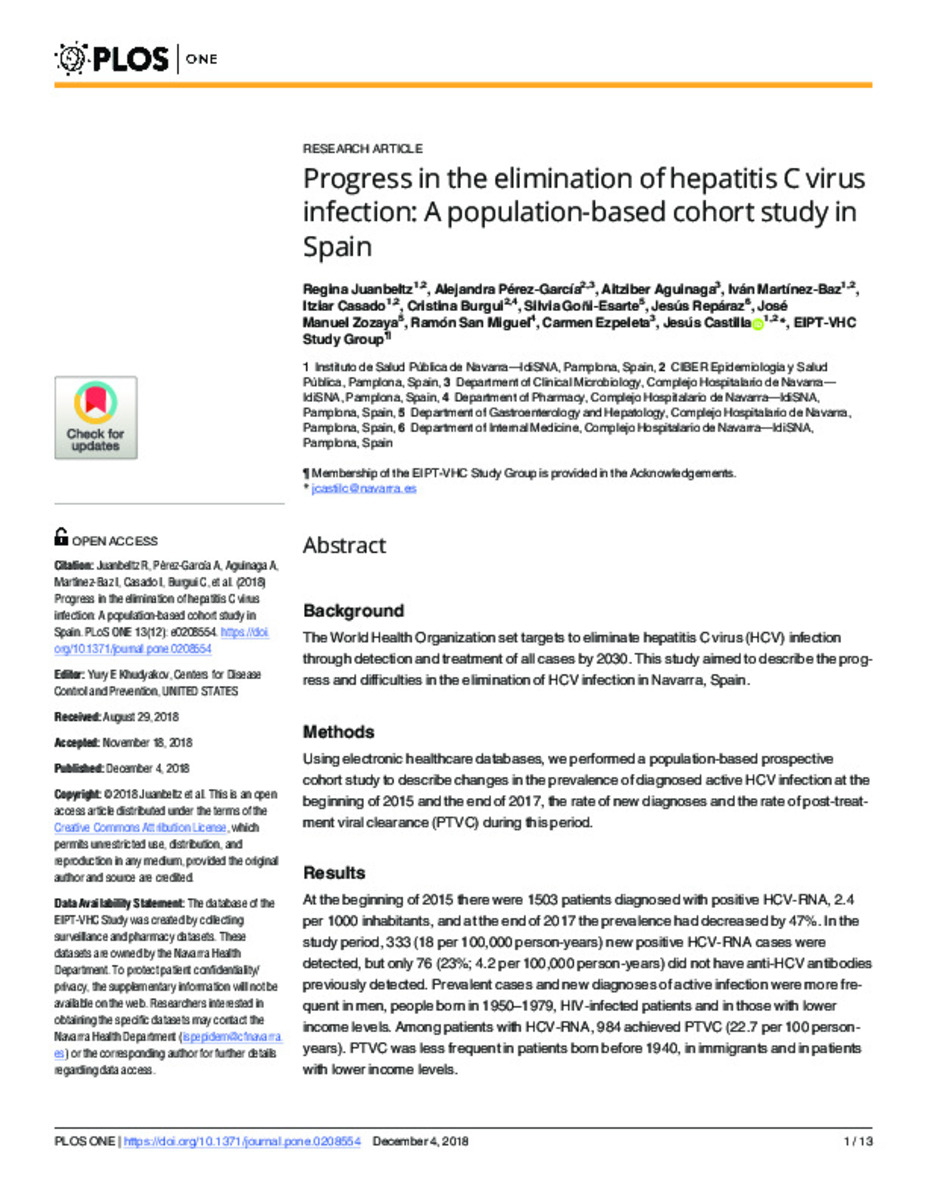Full metadata record
| DC Field | Value | Language |
|---|---|---|
| dc.creator | Juanbeltz, R. (Regina) | - |
| dc.creator | Pérez-García, A. (Alejandra) | - |
| dc.creator | Aguinaga, A. (Aitziber) | - |
| dc.creator | Martínez-Baz, I. (Iván) | - |
| dc.creator | Casado, I. (Itziar) | - |
| dc.creator | Burgui, C. (Cristina) | - |
| dc.creator | Goñi-Esarte, S. (Silvia) | - |
| dc.creator | Repáraz, J. (Jesús) | - |
| dc.creator | Zozaya, J.M. (José Manuel) | - |
| dc.creator | San-Miguel, R. (Ramon) | - |
| dc.creator | Ezpeleta, C. (Carmen) | - |
| dc.creator | Castilla, J. (Jesús) | - |
| dc.date.accessioned | 2023-02-14T09:29:33Z | - |
| dc.date.available | 2023-02-14T09:29:33Z | - |
| dc.date.issued | 2018 | - |
| dc.identifier.citation | Juanbeltz, R. (Regina); Pérez-García, A. (Alejandra); Aguinaga, A. (Aitziber); et al. "Progress in the elimination of hepatitis C virus infection in Spain: a population-based cohort study". Plos medicine. 13 (12), 2018, 1 - 13 | es |
| dc.identifier.issn | 1549-1277 | - |
| dc.identifier.uri | https://hdl.handle.net/10171/65453 | - |
| dc.description.abstract | Background: The World Health Organization set targets to eliminate hepatitis C virus (HCV) infection through detection and treatment of all cases by 2030. This study aimed to describe the progress and difficulties in the elimination of HCV infection in Navarra, Spain. Methods: Using electronic healthcare databases, we performed a population-based prospective cohort study to describe changes in the prevalence of diagnosed active HCV infection at the beginning of 2015 and the end of 2017, the rate of new diagnoses and the rate of post-treatment viral clearance (PTVC) during this period. Results: At the beginning of 2015 there were 1503 patients diagnosed with positive HCV-RNA, 2.4 per 1000 inhabitants, and at the end of 2017 the prevalence had decreased by 47%. In the study period, 333 (18 per 100,000 person-years) new positive HCV-RNA cases were detected, but only 76 (23%; 4.2 per 100,000 person-years) did not have anti-HCV antibodies previously detected. Prevalent cases and new diagnoses of active infection were more frequent in men, people born in 1950-1979, HIV-infected patients and in those with lower income levels. Among patients with HCV-RNA, 984 achieved PTVC (22.7 per 100 person-years). PTVC was less frequent in patients born before 1940, in immigrants and in patients with lower income levels. Conclusions: The prevalence of diagnosed active HCV infection has dropped by almost half over three years, because the number of patients with PTVC was much higher than the number of new diagnoses. Interventions specifically targeted at population groups with less favourable trends may be necessary. | es_ES |
| dc.description.sponsorship | This work is part of the EIPT-VHC project, which was supported by the Spanish Ministry of Health in the context of the “Strategic Plan for Tackling Hepatitis C in the Spanish National Health System” and by the Carlos III Institute of Health with the European Regional Development Fund (CM17/00095 and INT17/00066). The funders had no role in study design, data collection and analysis, decision to publish, or preparation of the manuscript. | es_ES |
| dc.language.iso | eng | es_ES |
| dc.publisher | Public Library of Science | es_ES |
| dc.rights | info:eu-repo/semantics/openAccess | es_ES |
| dc.subject | Hepatitis C virus (HCV) | es_ES |
| dc.subject | Post-treatment viral clearance (PTVC) | es_ES |
| dc.title | Progress in the elimination of hepatitis C virus infection in Spain: a population-based cohort study | es_ES |
| dc.type | info:eu-repo/semantics/article | es_ES |
| dc.description.note | This is an open access article distributed under the terms of the Creative Commons Attribution License, which permits unrestricted use, distribution, and reproduction in any medium, provided the original author and source are credited. | es_ES |
| dc.identifier.doi | 10.1371/journal.pone.0208554 | - |
| dadun.citation.endingPage | 13 | es_ES |
| dadun.citation.number | 12 | es_ES |
| dadun.citation.publicationName | Plos medicine | es_ES |
| dadun.citation.startingPage | 1 | es_ES |
| dadun.citation.volume | 13 | es_ES |
Files in This Item:
Statistics and impact
Items in Dadun are protected by copyright, with all rights reserved, unless otherwise indicated.






